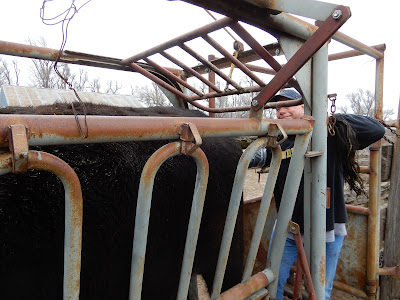
I am notoriously bad at numbers. Give me words any day.
My eyesight is also not the best, even with my ever-present glasses.
But if I have something in black and white that I can hold in my hand, things will go much more smoothly ... for everyone involved. (For the uninitiated, BWF means black white face.)
In a pinch, my hand works, too. (I didn't take the photo of my hand with manure on it. You're welcome.)
But at least my hand wasn't where Randy's was during this particular cattle-working adventure. We needed the list of numbers so that we could sort out four cows that hadn't yet calved and one mama whose baby had died.
Most of our mama cows have already had their calves. So Randy wanted to see if the stragglers were pregnant. After hauling them to the working chute, Randy gloved up with a plastic sleeve and did the exam.
I had to hold the end gate up on the working chute so it didn't inadvertently come down and hit Randy in the head.


We sent them into another pen to await the arrival of their calves. And, in fact, two of them had their calves a couple of days later. The cow whose calf had died was taken to the Pratt sale barn.

A BSE has three components:
- Scrotal circumference is highly correlated with semen output and serving capacity.
- A physical exam is performed to simply ensure that a bull is physically up to the challenge of the breeding season. Are his feet and legs structurally correct? Is he free from injury and/or infection?

- The veterinarian then examines the bull's semen to determine if the sperm cells are normal. After getting a sample, Dr. Figger smeared a sample on a slide and looked through the microscope.

Then he smeared the slide with a dye, which killed the sperm. He could then look at morphology, the shape of the sperm. He was looking for abnormalities in the shape, which could indicate a problem with the ability to breed.
 |
| Microscope photo credit to Dr. Bruce Figger |
The sperm in the upper left is healthy and correct. The sperm nearer to the light is not healthy. The bulls he tested were all fertile.
After the fertility tests, the bulls were each given vaccinations to keep them healthy during their summer in the pasture. It's similar to giving our children vaccinations for their optimal health. Their vaccinations prevent blackleg and BVD, a respiratory disease in cattle.

He also applied a pour-on de-licer.

The bulls are deemed ready for the job, but it will still be a couple of weeks of "vacation." Then we'll put them to work for their part in creating the Class of 2020.
I agree with most of the bullet points, though at the County Line, we do "fire" bulls for being obnoxious and destructive - especially if that "insubordination" is directed toward humans.
I agree with most of the bullet points, though at the County Line, we do "fire" bulls for being obnoxious and destructive - especially if that "insubordination" is directed toward humans.





Holding the gate...yup, that was my job too! It's great to hear all were pregnant. That always made Jim smile! We only had a bull to do the "clean up" work on our yearling heifers, but as soon as they got too big or showed aggression, we would get rid of ours too. "Never trust a bull" is our motto!
ReplyDeleteWe had another baby this morning. We are nearing the end of the stragglers.
DeleteI love the Hereford breed. D239 looks very impressive.
ReplyDeleteMy uncle farmed them but my Dad had Gurnseys and Jerseys for cream production in the 50's. We then moved state and the herd was a mixture of breeds for milk production.
I liked his curly hair. We have Hereford and Angus crosses.
DeleteThanks for sharing this great post.This is so nice.
ReplyDelete